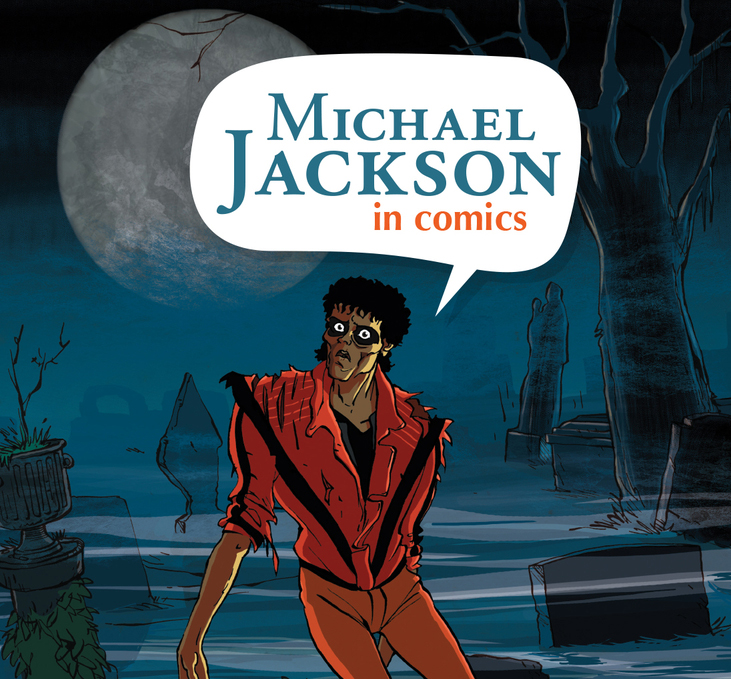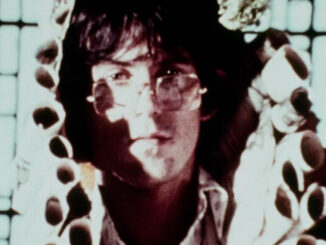
Who would have thought that the eighth child to a crane operator living in a two-bedroom house would one day go on to be the biggest selling artist of all time? Was this due to Michael’s talent being noticed quickly? From playing the bongos with his older brothers; Michael was quickly promoted to co-lead singer with his brother Jermaine. Was it that Michael was a fast learner? Diana Ross commented on how he learned the dance moves quicker than her and the other actors when filming “The Wiz” in 1977.
Irrespective of the opportunities presented; Michael Jackson went on to be the first solo artist to have four top ten hits off his first solo LP, Off the Wall. One more factor needs to be considered; Jackson’s tenacity to strive for more. Not content with picking up just one Grammy award for Off the Wall; Jackson would pick up eight (the most won in a year) for his follow up LP, Thriller.
Many of the comic strips see Michael narrate the story. The first sees Jackson describing his childhood “as an extremely difficult time” where he refers to his dad Joseph (who he could not call “dad” or “daddy”) as an “ogre”. Denied the opportunities to play in the yard with other children and working to a gruelling schedule of practising and entering music competitions with his brothers; Michael explains that as an adult he spent his “whole life chasing after that stolen childhood of mine”. Whilst this comic strip doesn’t cover new ground or references the lyrics from Michael’s 1995 song “Childhood”; the comic strip deftly leaves the reader wanting to light a candle in memory of Jackson’s lost childhood.
Michael Jackson in Comics quotes Michael being described as “pathologically shy” and that “Michael helped fuelled the confusion…” that led to rumours being circulated about him including “paedophilia”. The events involving the Arvizo Trial and Jordan Chandler are described; the furthest Michael Jackson in Comics goes regarding disputing Jackson’s narratives is Jackson and Diana Ross (who he lived with when he was nine years old) were more than “Just Good Friends”. Whilst one sees Michael’s changing appearance; seldom a reference is made to surgery.
Michael Jackson, in Comics, tells the story of the struggle and fight against racism with dignity and grace with a cameo from David Bowie. Despite the success of Off the Wall and Thriller; Michael was still denied the opportunity to appear on the front cover of Rolling Stone magazine. This only changed in 1981, when Walter Yetnikoff, the “influential” CBS Records President, directly accused the publication of being “racist”. Yetnikoff would intervene again in 1983 when MTV underrepresented black artists because they did not fit “the rock format” by threatening to withdraw white artists’ videos who were signed to CBS if they did not air Michael Jacksons “Beat It” and “Billie Jean” videos. Black artists would become “the biggest stars on MTV”, and in 1984, MTV requested exclusive rights to the “Thriller” video.
Michael Jackson’s relationship with Paul McCartney is adroitly presented in comic format from the recording of “The Girl is Mine”, making “Say, Say, Say” in the place that Michael would buy and name Neverland, and the duo’s fall out, when Jackson bought ATV Music Publishing’s 50% share of the royalties to most of the Beatles songs. Ironically, Michael got the idea to invest in song rights from Macca himself. Look out for the strip which sees the two artists quibble under the banner: The Rights Are Mine.
The strips depicting the artists such as James Brown, who inspired Jackson’s dance moves and act, along with early pioneers, who had developed versions of the moonwalk, such as Marcel Marceau, are fascinating. The sketches of Jackson himself doing the moonwalk (a term Jackson coined) and “toe stance” with his white socks, gloves with silver sequined gloves and fedora hat remind us that he earned the title “King of Pop” by being a musical pioneer.
The querkist cartoons sees Bubbles (Michael Jackson’s pet chimp) giving a tour of Neverland to a journalist after Michael’s death in 2009. Bubbles tells the journalist (whilst partaking on Neverland’s many theme park rides) about Jackson’s love for all animals (except dogs). Bubbles explains how Jackson rescued him from a “med lab” in 1985. We are introduced to Muscles the Boa (also a song Michael wrote for Diana Ross), Gypsy the elephant (gifted to Jackson by Elizabeth Taylor) and Thriller the tiger, who appeared on Jackson’s sophomore solo LP as a cub. Another strip sees Peter Pan act as an estate agent for the Neverland ranch. Jackson’s brief marriage to Lisa-Marie Presley is told as an eccentric fairy-tale about how the daughter of a king would one day marry a king – “the king of pop”.
The ongoing charity work and charitable foundations Jackson set up with their origins are informatively documented. The most emotional story involved Ryan White – a haemophilic boy who contracted aids after receiving a blood transfusion. Ryan, who had been expelled from school and shunned by friends, participated in numerous public benefits for children with AIDS. Celebrities, including Jackson, appeared with him. White died in 1990, aged 18. White’s legacy was the Ryan White Care Act passed by Congress to help fund treatment for those diagnosed with AIDS. Michael wrote “Gone too Soon” in Ryan’s memory.
Michael Jackson, in Comics, with amazing colour, ebullient imagination and dignity, allows the reader to revisit the key events in Jackson’s career and personal life. The person presented is naturally talented, hardworking, eccentric, and an outsider with a heart of gold. Unfortunately, this person’s inability to fully articulate and convince the media (especially in the USA) of some of his behaviours, along with his inability to mourn and move on from his lost childhood, led to ongoing media mistrust. Whilst Michael Jackson in Comics doesn’t cover new ground, or offer new analysis; Michael Jackson in Comics salutes a musical pioneer who rose above poverty and racism to become an innovator who continues after his death to be triumphant in so many ways beyond record sales.





Be the first to comment